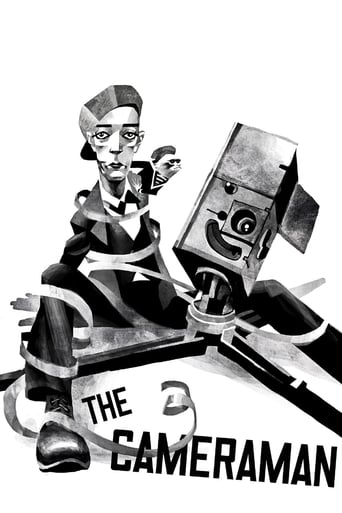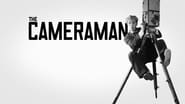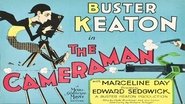Antonius Block
This is such a brilliant little movie, so far ahead of its time, and like the rest of Keaton's work, so influential for generations to come. There are comedy bits that are still fresh today, a sweet romance blended in, and what seems like one great scene after another for 67 minutes.Keaton's character is lovable as a sweet guy who has fallen for a women (Marceline Day) who works in a newsreel agency, and who tries his best to 'make good' there as a cameraman. He runs to jump on a firetruck on the way to filming a fire, only to find out it's going back to its station. He goes out to the ballpark to cover the game, only to find out the Yankees are on the road in St. Louis that day, and then proceeds to skillfully pantomime pitching, batting, and running the bases. Later in the film, he'll get a monkey as a sidekick on his way to filming a Chinese holiday celebration that turns into an all-out gang war. By the way, that monkey is fantastic, and clearly well-trained.On the romantic side, Keaton convinces Day to go out with him, and after eagerly waiting for her call, tears down the stairs when the phone rings, with the camera following him in a nice side view all the way. Day is pursued by others who are more polished and better off than Keaton, but her character recognizes his sweetness and tries to look out for him. Keaton's physical comedy is brilliant while embarrassed in a room full of girls at her residence while waiting for her to come out, and then later as he crawls from the top of a double-decker bus to the lower level where she sits after they've been separated. There are then some excellent scenes at the pool: first, him changing in a very small space with another man, and then later losing his oversized swim trunks in the pool.This is a comedy that shows a lot of creativity and skill, but also manages to be touching and heartfelt. Its pace is great and there is never a dull moment with Keaton on the screen. Day is quite fetching as well. Great movie.
prettycleverfilmgal
I'll get to The Cameraman in a sec, just bear with me. Did you watch Lost? I hope, for your sake, that the answer is no. I mean, c'mon – J.J. Abrams, I'm going to kick your ass in a dark alley if I ever get the chance, just for wasting my time. But I digress. I merely mention this to point out the character of Desmond Hume, who wags around the one Dickens novel, Our Mutual Friend, that he's saving. 'Cause see, I do that too. As a matter of fact, I'm sitting on Martin Chuzzlewit by Dickens, Pic by Jack Kerouac, and one lone piece from Joseph Mitchell's Up in the Old Hotel. Please don't tell me how tragic and regrettable this will be if I get hit by a bus… I know, I know.All of this is to say that recently, I went to a screening of The Cameraman (1928) starring the one and only Buster Keaton. And this was the one and only Buster Keaton film I've never seen. So before you gasp and clutch your chest and say, "But Pretty Clever Film Gal, how could you neglect to see a Buster Keaton movie!?!" I refer you to my opening salvo above. Buster Keaton movies are rare and precious commodities. It's not like we're getting any new ones, unless somebody decides to use his powers for good not evil (I'm looking at you, James Cameron.) However, when you have the opportunity to see a Buster Keaton movie in a theater with music accompaniment from William O'Meara, well preciousness has to be put aside.The Cameraman-poster-Buster KeatonEric Veillette, impresario of Silent Sundays at the Revue Cinema and Silent Toronto perpetrator, introduced The Cameraman as Keaton's last great film, which is a fair assessment. Careful readers may have noticed that I did not refer to the movie as "Buster Keaton's The Cameraman," but merely stated that it starred Keaton. Though Keaton was an auteur before there was such a thing, writing, directing, editing, I suspect even catering all of his features up 'til this point, The Cameraman was directed by Edward Sedgwick. Notably, this movie was Keaton's first under his brand spankin' new contract with MGM. Things would go from bad to worse for Keaton and MGM, and in a little less than a year, creative control of his films would be wrested out of his hands. Keaton later called the move to MGM "The worst mistake of my career." Considering what followed, he's exactly right.But that's later. In 1928, The Cameraman has Keaton's fingerprints all over it. Sedgwick may have held the title of director, but no body puts Buster in the corner apparently, or at least not yet. As a filmmaker, Keaton is all about control – having it, losing it, regaining it. His films are precise, always demonstrating that's there's nothing coincidental about a good gag. Comedy is a presentation, dependent on timing and control and Keaton's work reflects this, always. So despite being stripped of the titular role of director, it's impossible to assert with a straight face that The Cameraman, perhaps one of his most self-reflexive works, was not firmly in Keaton's control.The Cameraman-Buster KeatonThe movie abounds with gags the define Keaton's preoccupation with control, or lack thereof. When he pawns his tintype machine to buy an outdated, hand cranked movie camera, all in the service of getting closer to Sally, the newsreel production office receptionist, things spin out of Buster's control pretty damn fast. His initial salvo in newsreel shooting results in a tragic mess of double exposed images – a battleship sailing down a Manhattan street, most notably. Forget the mechanics even – Buster struggles with the physicality of the machine itself, breaking the glass in the office door multiple times. In the end, the star cameraman of The Cameraman is a monkey, for pete's sake. Which might be a metaphor for Keaton's entire career: an aimless amateurism produces iffy experimental results, and an unrestrained primitivism produces a heroic quality results (not to mention funny results). Take that, MGM studio stooges! I think there's another point worth making about Buster Keaton and The Cameraman. Turns out, Buster is a fine actor. His previous, auteur-like body of work demonstrates beyond a doubt that Buster is fantastic performer, honed from basically being born on a vaudeville stage. He always had the timing, the exploitation and confounding of expectation to provoke a reaction, but did Buster ever act, did he build a character and flesh out a role? Perhaps freed from the rigors of being the writer-director-caterer, Buster is free to be our hapless little cameraman, so complete that when Sally rejects him, it will bring a tear to your eye. That's not the typical response to your typical slapstick and reflects the elevation of Buster's small-man-in-a-big-world character beyond mere comedy prop.With hindsight being 20/20, it's difficult to not find a tinge of the bittersweet in The Cameraman, solely because it is Buster Keaton's last great film. It is, sadly, mostly downhill for Buster from there. But, for all that, The Cameraman is not to be missed.
romanorum1
Film historians know that Buster Keaton signed on as a contract player with MGM Studios after his contract with independent producer Joseph M. Schenck expired in 1928. His signing was done at the urging of his relatives but against the advice of mega-star comedians Charlie Chaplain and Harold Lloyd. An advantage of the new arrangement was that there would no longer be problems of raising cash since MGM was large and rich. A disadvantage is that Keaton gradually gave up his filmmaking independence, like directing and improvising, to a studio that insisted upon strict control. Even though the box office tabulation would undeniably improve – MGM moguls could claim that they were right after all – the payoff over time would be disastrous for one who was a silent film giant. But the day seemed to be ending for 1920s slapstick silent stars. New comedians were on the rise, like the Marx Brothers (whom Keaton loathed). Whatever Keaton's future problems, the new agreement certainly began well, as his first MGM effort, The Cameraman, shows little, if any, waning from some of his great movies. There are gags galore, and pathos, and on-location shooting, and more. Keaton is a clumsy tintype photographer (appropriately named Buster) who desires to become a great studio newsreel cameraman at MGM Offices in order to impress Sally, a lovely lass. He had met her at a ticker-tape parade (which looks very much like a World War I coming-home gala, 1919). But Buster's first efforts are hopeless, as his double-exposures leave the studio chiefs laughing in stitches. Meanwhile he has inadvertently broken the door glass at MGM several times. So it is that Buster embarks upon New York City to find stories to film while wielding a lumbering movie camera. The upshot is that there are many funny vignettes. Here are a few: (1) The one-man baseball-pantomime at Yankee Stadium with a Ruthian figure in civilian clothes – with hands on hips – observing the action. Actually Buster, looking for action, did not realize that the Yankees were playing the St. Louis Browns on the road that day. (2) Buster running non-stop from his Manhattan place to Sally's before she has hung up the telephone. (3) Buster's attempts to break into his piggy-bank to gather his precious dimes; he damages his apartment. (4) The separation of Buster and Sally on two different levels of the over-crowded Manhattan bus. (5) The clothing change in a locker room. By the way, Sally (Marceline Day) looks fabulous in her 1920s bathing gear. (6) Buster losing his over-sized bathing outfit while in the pool. (7) The hilarious Tong War in Chinatown, with a monkey in a sailor-suit using a machine gun. This scene reminds one of Cheetah machine-gunning Nazis who had invaded Tarzan's African domain years later (1943). (8) The boating scene whereby Buster saves Sally from an unmanned motorboat. His rival, though, initially received the credit and left the romantic Buster heartbroken. It's serendipity that the monkey knew how to operate the movie camera! Look fast for Charles Lindbergh in the parade at movie's end (newsreel footage). This film was followed by Keaton's last silent (with sound effects but without dialog) – the humorous but underrated Spite Marriage (1929). Soon after conditions deteriorated, as 1930 was just around the corner, and the decade of the 1930s was Keaton's worst decade in more ways than one. The star's later state of affairs was not helped along by his extramarital affairs and his drinking. But, for now, the situation looked fine for one whom Roger Ebert ultimately considers the most courageous silent movie comedian of all time. Indeed, Buster Keaton was a unique comedy talent, maybe the greatest one in world cinema history.






